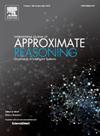基于趋势模式无限模糊信息颗粒的长期时间序列预测LSTM模型
IF 3
3区 计算机科学
Q2 COMPUTER SCIENCE, ARTIFICIAL INTELLIGENCE
引用次数: 0
摘要
趋势模糊信息粒化在长期时间序列预测中显示出良好的效果,受到越来越多的关注。在基于趋势模糊信息粒化的预测模型中,趋势粒化的表示起着至关重要的作用。研究重点是发展趋势颗粒和趋势颗粒时间序列,以有效地表示趋势信息,提高预测性能。然而,现有的趋势模糊信息造粒方法对颗粒的趋势模式进行了假设(即假设颗粒具有线性趋势或确定的非线性趋势)。具有预设趋势模式的模糊信息颗粒的表达能力有限,难以捕捉复杂的非线性趋势和时间依赖性,从而限制了其预测性能。为了解决这一问题,本文提出了一种新的趋势模糊信息颗粒,即趋势模式无限模糊信息颗粒(TPUFIGs),该颗粒由具有自动特征学习和非线性建模能力的循环自编码器构造。与现有的趋势模糊信息颗粒相比,TPUFIGs能够更好地表征潜在的趋势模式和时间依赖性,具有更强的鲁棒性。结合tpufig和LSTM神经网络,设计了TPUFIG-LSTM预测模型,有效地缓解了误差积累,提高了预测能力。在6个异构时间序列数据集上的实验结果表明了该模型的优越性。该模糊信息粒化方法将深度学习与颗粒计算相结合,更有效地表征了时间序列中复杂的动态特征,为长期时间序列预测提供了一种新的解决方案,提高了预测精度和泛化能力。本文章由计算机程序翻译,如有差异,请以英文原文为准。
Trend-pattern unlimited fuzzy information granule-based LSTM model for long-term time-series forecasting
Trend fuzzy information granulation has shown promising results in long-term time-series forecasting and has attracted increasing attention. In the forecasting model based on trend fuzzy information granulation, the representation of trend granules plays a crucial role. The research focuses on developing trend granules and trend granular time series to effectively represent trend information and improve forecasting performance. However, the existing trend fuzzy information granulation methods make assumptions about the trend pattern of granules (i.e., assuming that granules have linear trends or definite nonlinear trends). Fuzzy information granules with presupposed trend patterns have limited expressive ability and struggle to capture complex nonlinear trends and temporal dependencies, thus limiting their forecasting performance. To address this issue, this paper proposes a novel kind of trend fuzzy information granules, named Trend-Pattern Unlimited Fuzzy Information Granules (TPUFIGs), which are constructed by the recurrent autoencoder with automatic feature learning and nonlinear modeling capabilities. Compared with the existing trend fuzzy information granules, TPUFIGs can better characterize potential trend patterns and temporal dependencies, and exhibit stronger robustness. With the TPUFIGs and Long Short-Term Memory (LSTM) neural network, we design the TPUFIG-LSTM forecasting model, which can effectively alleviate error accumulation and improve forecasting capability. Experimental results on six heterogeneous time series datasets demonstrate the superior performance of the proposed model. By combining deep learning and granular computing, this fuzzy information granulation method characterizes intricate dynamic features in time series more effectively, thus providing a novel solution for long-term time series forecasting with improved forecasting accuracy and generalization capability.
求助全文
通过发布文献求助,成功后即可免费获取论文全文。
去求助
来源期刊

International Journal of Approximate Reasoning
工程技术-计算机:人工智能
CiteScore
6.90
自引率
12.80%
发文量
170
审稿时长
67 days
期刊介绍:
The International Journal of Approximate Reasoning is intended to serve as a forum for the treatment of imprecision and uncertainty in Artificial and Computational Intelligence, covering both the foundations of uncertainty theories, and the design of intelligent systems for scientific and engineering applications. It publishes high-quality research papers describing theoretical developments or innovative applications, as well as review articles on topics of general interest.
Relevant topics include, but are not limited to, probabilistic reasoning and Bayesian networks, imprecise probabilities, random sets, belief functions (Dempster-Shafer theory), possibility theory, fuzzy sets, rough sets, decision theory, non-additive measures and integrals, qualitative reasoning about uncertainty, comparative probability orderings, game-theoretic probability, default reasoning, nonstandard logics, argumentation systems, inconsistency tolerant reasoning, elicitation techniques, philosophical foundations and psychological models of uncertain reasoning.
Domains of application for uncertain reasoning systems include risk analysis and assessment, information retrieval and database design, information fusion, machine learning, data and web mining, computer vision, image and signal processing, intelligent data analysis, statistics, multi-agent systems, etc.
 求助内容:
求助内容: 应助结果提醒方式:
应助结果提醒方式:


